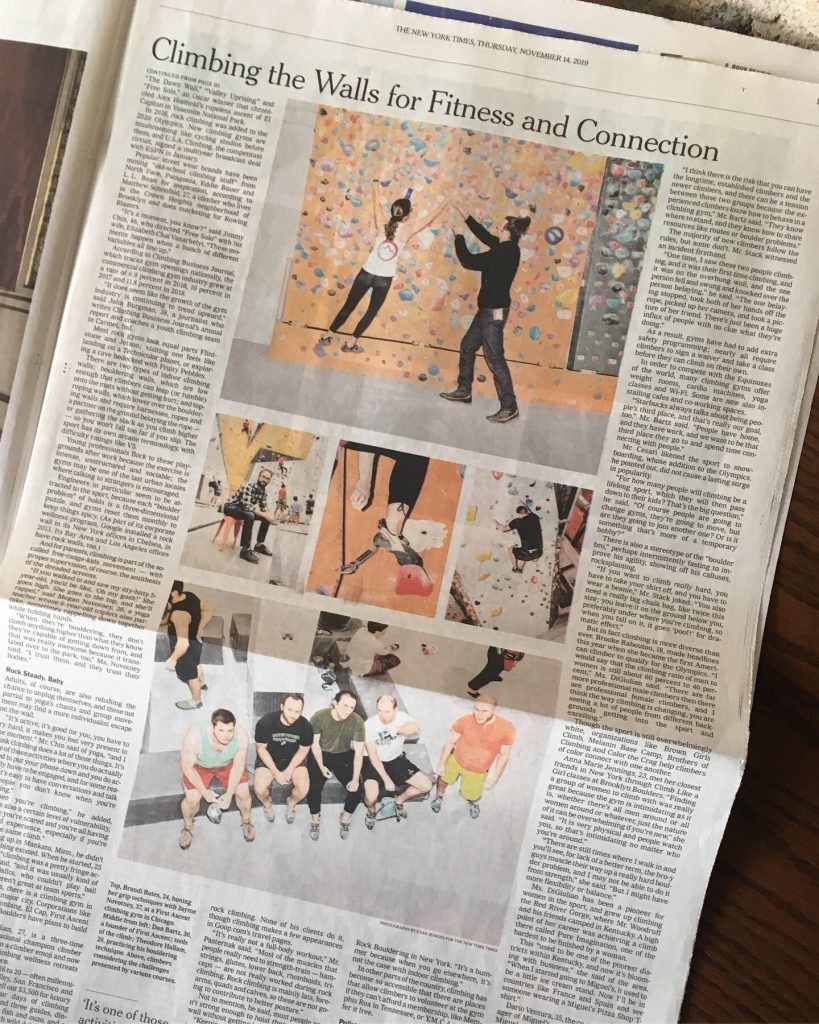Last week, the New York Times featured First Ascent in a full-page Style section article discussing the rise of climbing in the US over the last 5 years.
That was an exciting moment for us at First Ascent. All of the photos from the piece were taken at First Ascent Avondale, and I was quoted discussing our role in fostering community, connecting people, and helping bridge the culture gap between new and experienced climbers. Other FA climbers (Zack Woodruff and Megan Novotney) told stories about traveling to the Red River Gorge and climbing with their kids.

We were stoked to see First Ascent featured in this climbing “moment”, as Jimmy Chin describes it in the article. We opened our first location just over 4 years ago, and it’s rewarding to see the work we’ve put into our gyms be recognized on a national scale. But more importantly, we consider serving this growing community of climbers an enormous privilege – one we don’t take lightly.
That’s why I’m writing here in response to a part of the article that struck me and many climbers as fundamentally untrue of the sport of climbing and the climbing community as a whole:
“Keeping in mind the average American is significantly overweight, I would talk everyone I could out of rock climbing unless you are incredibly light, agile, fit and functional,” said Harley Pasternak, 45. “There is a very small minority of this country that should be rock climbing.”
I respect Harley Pasternak’s experience and expertise in fitness and nutrition, but we need to set the record straight.
Climbing is for everybody. Every. Body.
I don’t just say this as an industry idealist. I say it because I’m part of an extremely diverse, inclusive community of climbers inhabiting our gyms every day.
Come observe a First Ascent gym any night of the week, and you’ll find climbers of all ages, body types, sizes, ability levels, and backgrounds pursuing adventure, fitness, and community through climbing. What’s more, that community of climbers is incredibly welcoming and encouraging to new climbers, no matter their fitness level. It doesn’t matter how long you’ve been climbing or how hard you can climb – we’re all pushing our own limits, so we’re all on the same team when it comes to sending.
To say that climbing is only for the fit elite is a complete mischaracterization of the climbing community I know and love.
For some people, modifications are necessary to climb, but that’s no different than any other sport or activity. Our routesetting team works hard to set climbs for all ages, body sizes, and ability levels so everyone can enjoy a first ascent on their first visit, then challenge themselves with more difficult climbs as they progress. We partner with Adaptive Adventures to lead adaptive climbing meetups where climbers use special prostheses or rigging to climb despite physical or neurological disabilities. We recommend that folks with previous ankle or knee injuries, osteoporosis, and other conditions that leave them susceptible to limb injuries stick to roped climbing and avoid bouldering, since that style of climbing involves ground falls down to a pad instead of a harness and rope to protect falls. Sure, certain styles of climbing are reserved for advanced climbers (lead climbing, for instance), but with the correct modifications and equipment in place, the inherent challenge and joy of climbing is available to everyone.
Of course, climbing involves inherent risks – gravity works, as the saying goes – and we’re clear with everyone who walks through our doors about the risks associated with climbing. With proper equipment and training, however, there’s something about defying gravity in community that is life changing.
I’ve watched countless people become more alive and more themselves through climbing: taking back control of their health and fitness, battling their sedentary work lives, disconnecting from devices and reconnecting with people in the present moment, enjoying being active with their kids and families, overcoming a fear of heights or feelings of self doubt – and the list goes on. I know these stories well, partly because I’ve experienced a similar transformation myself. I discovered climbing as an out-of-shape college student who never quite fit into the sports or fitness worlds, and needless to say, it altered the course of my life in ways I never would have imagined that first day at the climbing gym. Climbing has the ability to change lives, and that opportunity is available to anyone and everyone – particularly those who might not fit into more traditional sports or fitness activities.
I’m glad to see the climbing community stand up and respond to the article. Countless climbers commented on the New York Times Instagram post to stand up for climbers of all body types and ability levels. Sasha Digiulian posted a call to action via Instagram yesterday, with thousands of likes and hundreds of comments. This is the community I know and love standing up for what we believe in.
We at First Ascent will continue to do our part to give everyone – every body – a chance to discover climbing in a positive, supportive, judgment-free environment. We are grateful to the climbing community we serve for helping us uphold a warm, welcoming vibe in our gyms. And we encourage everyone who is curious about climbing to prove the naysayers wrong and come give it a go. We’d be happy to show you the ropes.
Climb on, y’all!
Dan Bartz
Co-founder, First Ascent Climbing & Fitness
